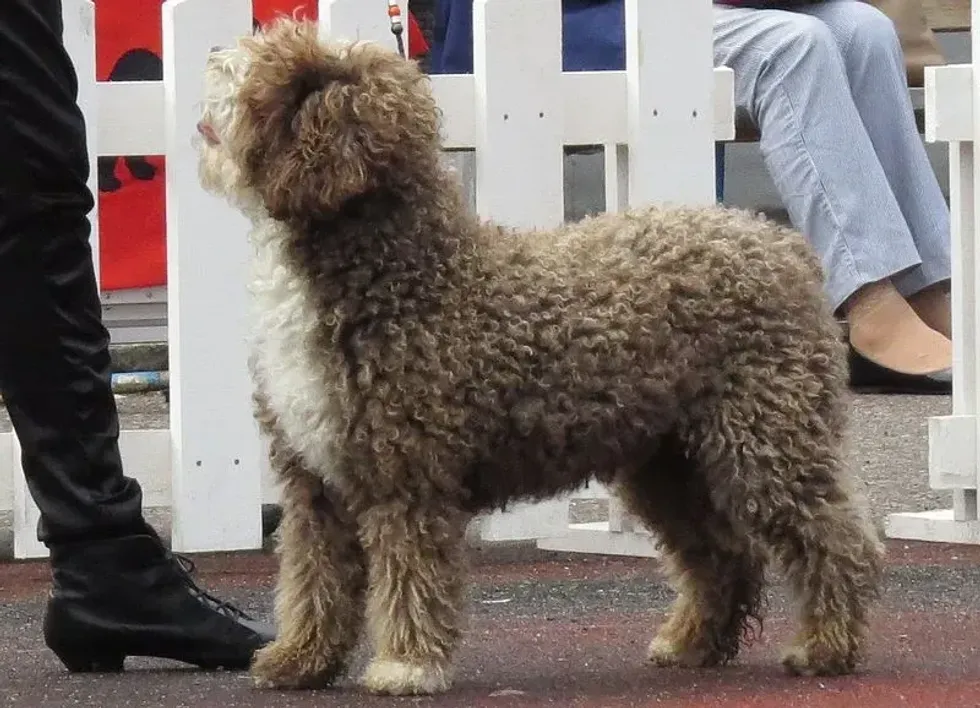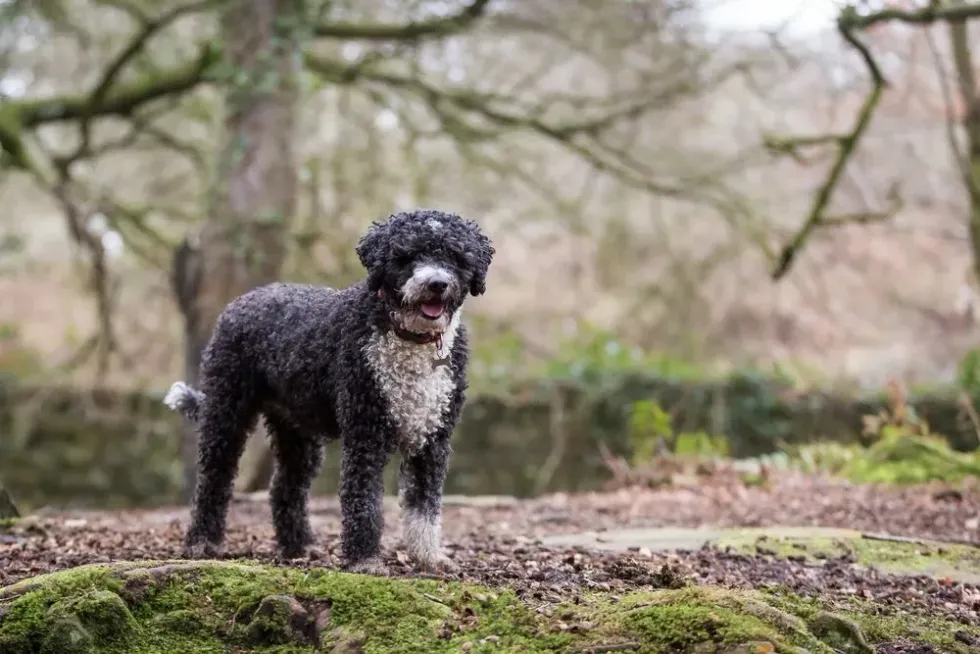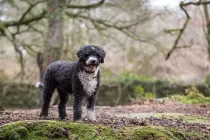Fun Spanish Water Dog Facts For Kids

The Spanish water dog is a domesticated dog, classified in the herding group by the American Kennel Club or AKC. These dogs are known for their curly and woolly coat, and energetic personalities. They usually come in brown, black, beige, white, or dual colors and have minimal shedding.
These dogs are very intelligent in nature and can be trained to participate in games and sports. Being a herding dog, they have protective instincts which need to be kept under control by training them from an early age.
According to the standards provided by the American Kennel Club or AKC, the head of this dog should be balanced with respect to the rest of the body and they should have triangular ears which are drooping.
This is one of the rarer dog breeds and has the rank of 153 in the AKC breed popularity list. Those who are looking to own a Spanish water dog should get one from a reputable breeder or reliable rescue center.
To learn more about the Spanish water dog, keep reading! You can also check out our articles on the Ibizan hound and the prairie dog for more fun animal facts.
Spanish Water Dog Interesting Facts
What type of animal is a Spanish water dog?
Spanish water dogs are a domestic breed of dog, belonging to the herding group in the American Kennel Club or AKC. In the past, these dogs were used for a variety of purposes like herding, hunting, farm-work, protection, and retrieving waterfowl. Nowadays, they are also seen participating in dog sports.
What class of animal does a Spanish water dog belong to?
This animal is part of the class Mammalia. They are a member of the Canidae family and have the scientific name Canis lupus familiaris, which is used for all domesticated breeds of dogs.
How many Spanish water dogs are there in the world?
The global population of this dog is difficult to ascertain. In the United States and Canada, there are about 1000 Spanish water dogs.
Where does a Spanish water dog live?
The history of the origin of Spanish water dogs is not precisely known, however these dogs have resided in Spain for several years. They are known as perro de agua Español in Spain.
The term 'perro de agua' means 'water dog', while 'Español' means 'Spanish'. Until 1975, this breed was quite obscure, before enthusiasts decided to make this dog the national breed of Spain.
To this day, Spanish water dogs are one of the most popular breeds in Spain, even though they aren't the official national dog. Apart from that, this breed can be found in several places around the world from any specialized breeder or rescue center.
What is a Spanish water dog's habitat?
Spanish water dogs can adapt to any kind of climate. They are usually found in houses, apartments, or farms. These dogs do well in open spaces. However, it is best to have fenced areas so that they don't run away.
Who do Spanish water dogs live with?
Just like German shephards, Spanish water dogs are perfectly capable of living with humans. In fact, they do not like to stay away from their owners for a long time.
A Spanish water dog or SWD is quite friendly in nature, but they can be aggressive towards strangers. It is essential to let them socialize from when they are puppies to get rid of any behavioral problems.
Early socialization in a Spanish water dog puppy can also enable them to live with children and other pet animals. Since they belong to the herding group, they can live near sheep as well.
How long does a Spanish water dog live?
A Spanish water dog's life expectancy is between 12-14 years. Its life can be cut short by health issues and illnesses like hip dysplasia, neuroaxonal dystrophy, and progressive retinal atrophy. Spanish water dog health should be maintained by giving them proper food, regularly visiting veterinarians, and letting them exercise.
How do they reproduce?
The pattern of reproduction in Spanish water dogs is the same as other dog breeds. Female dogs are said to be in heat when they are fertile and this is when mating takes place.
After a gestation period of about 63 days, four to six puppies are born. Each puppy also has a woolly coat which is typical of this dog group.
What is their conservation status?
The conservation status of the Spanish water dog or SWD is Not Evaluated according to the International Union for Conservation of Nature or IUCN. Since this is a domesticated breed, there are breeders who maintain the population of these dogs. Nevertheless, this is considered to be one of the rarer dog breeds.
Spanish Water Dog Fun Facts
What do Spanish water dogs look like?
A Spanish water dog has quite a distinctive appearance. They are mainly known for their curly and single coat which covers their whole body including the head.
Sometimes, the wooly and curly coat forms cords with curled tips. The coat can have colors like black, beige, white, or brown. Some Spanish water dogs also have a two-colored coat, out of which one color is always white.
These dogs are medium-sized and have an athletic build that further enhances their appearance. Their ears are set at a medium level on their head and are triangular in shape. The eyes of a Spanish water dog are described as being expressive.
The eye color depends on the coat color and is usually hazel, brown, or chestnut. They have straight legs with well-arched toes and some webbing on the feet.

How cute are they?
This domestic dog breed of medium size has an extremely cute and adorable appearance, similar to Greenland dogs. Their beautiful coats with natural curls that form cords make them a desirable breed. Additionally, they display high levels of energy and playfulness which makes them a good companion. The Spanish water dog puppy is also very cute.
How do they communicate?
The Spanish water dog or SWD communicates using the same methods as any other dog breed. They usually bark or display various tail positions to express themselves. Other kinds of body postures may also be used by the dog to communicate.
Since Spanish water dogs are protective in nature, they tend to bark when alarmed about any possible danger. Other reasons for barking are boredom, greeting someone, or anxiety. In general, this breed has a medium barking tendency and isn't particularly loud or noisy.
How big is a Spanish water dog ?
Spanish water dogs are medium in size. Their length is slightly greater than their height.
The male dogs of this breed have a height between 17.5-19.7 in (44.4-50 cm), while the female dogs are between 15.7-18 in (39.8-45.7 cm). Spanish water dogs are somewhat shorter than another domestic dog breed, known as the Portuguese water dog.
The males of this breed are between 20-23 in (50.8-58.4 cm) tall, while the females are between 17-21 in (43.1-53.3 cm) tall.
How fast can a Spanish water dog run?
Being a highly energetic breed, Spanish water dogs are very athletic and fast. They enjoy being outdoors and running around.
It is essential for owners to keep exercise as a part of the daily routine of their Spanish water dogs. At the very least, these dogs should be taken out for a walk every day to keep their energy levels in check. As the name might suggest, they are also efficient swimmers.
How much does a Spanish water dog weigh?
The weight of a male Spanish water dog is between 40-49 lb (18.1-22.2 kg). The females of this breed are lighter than the male dogs and weigh between 31-40 lb (14-18.1 kg).
What are the male and female names of the species?
A male Spanish water dog is simply known as a dog, while a female is known as a bitch.
What would you call a baby Spanish water dog ?
A baby Spanish water dog is known as a puppy.
What do they eat?
Just like any other dog breed, the Spanish water dog also requires a balanced diet to maintain their health. These dogs can be fed any good quality store-bought dog food.
They also do well with homemade food, as long as the owners know the right kind of food items that can be fed to their dog. The diet of these dogs should be modified depending on their activity and exercise levels.
The dogs of this breed who are highly active must be fed high amounts of fat and calories. However, those who are not as active do better with a more balanced meal.
Spanish water dogs need to be fed twice a day. They can also be given treats, but care should be taken so that they don't eat too many treats and become obese.
Are they slobbery?
The Spanish water dog is not prone to being slobbery or drooling. However, the puppies tend to drool a little when they are growing teeth. Sometimes, drooling in Spanish water dogs can indicate health problems like stomach infections and dental problems.
Would they make a good pet?
The Spanish water dog is an impressive breed, famous for its curly coat with cords covering its entire body like Texas heeler. They are very active and highly intelligent, making them the perfect pet for active owners.
However, there are some requirements that need to be kept in mind before getting this breed. Spanish water dogs require a good amount of training and socialization from an early age so that they can get along with different people, including small children. Proper socialization is one of the main factors behind a friendly Spanish water dog.
Otherwise, they might turn out to be aggressive, especially towards strangers. They also require some form of exercise every day, attributing to their high energy.
Their grooming requirements are a bit different due to their curled and wooly coat. Usually, their coat is never brushed or trimmed.
Nevertheless, some owners or breeders might opt to cut the hair of the coat up to a certain length from time to time. Long coat hair forms cords which might require professional grooming to be maintained. Additionally, even though their coat is not naturally smelly, water and dirt can cause the dog to stink, necessitating grooming.
Make sure you use a reputable breeder or visit a rescue center.
Did you know...
The Spanish water dog's history and origin are often disputed. One theory suggests that Turkish traders brought this breed to Spain.
Hence, another name for the Spanish water dog is the Turkish dog. The other theory suggests that the breed originated in Africa and was brought to Spain by the Moors. Either way, this breed has been present in the Iberian Peninsula, which consists of Spain and Portugal, for nearly 1000 years.
Another name for this dog is Turco Andaluz.
The Spanish water dog is the 187th breed in the American Kennel Club or AKC. This breed was recognized by the AKC in 2015.
There is a Spanish water dog club in America which provides necessary information about this breed to breeders and fanciers.
Are Spanish water dogs hypo allergic?
The Spanish water dog is not a hypoallergenic breed, even though they are not prone to shedding. People with severe allergies to dog hair should be cautious.
Can a Spanish water dog be left alone?
Spanish water dogs do not do well with being left alone for long periods of time like the Alaskan husky. They are very affectionate and loyal towards their owners and love being around them.
If these dogs have to spend a prolonged period of time away from their family, they might develop separation anxiety. Additionally, being one of the most active breeds, a Spanish water dog will enjoy performing activities with its owner.
Here at Kidadl, we have carefully created lots of interesting family-friendly animal facts for everyone to discover! For more relatable content, check out these false killer whale facts and whippet dog facts for kids.
You can even occupy yourself at home by coloring in one of our free printable Spanish water dog coloring pages.
We Want Your Photos!
More for You
See All
Bachelor of Arts specializing in Journalism and Mass Communication, Postgraduate Diploma in Sports Management

Moumita DuttaBachelor of Arts specializing in Journalism and Mass Communication, Postgraduate Diploma in Sports Management
A content writer and editor with a passion for sports, Moumita has honed her skills in producing compelling match reports and stories about sporting heroes. She holds a degree in Journalism and Mass Communication from the Indian Institute of Social Welfare and Business Management, Calcutta University, alongside a postgraduate diploma in Sports Management.
Postgraduate Diploma in Management

Sakshi RaturiPostgraduate Diploma in Management
Sakshi has experience in marketing strategy, social media planning, and recruiting industry experts for capstone projects, she has displayed a commitment to enhancing their skills and knowledge. She has won multiple awards, including a Certificate of Appreciation for Creative Writing and a Certificate of Merit for Immaculate Turut, and is always seeking new opportunities to grow and develop.
Disclaimer
1) Kidadl is independent and to make our service free to you the reader we are supported by advertising. We hope you love our recommendations for products and services! What we suggest is selected independently by the Kidadl team. If you purchase using the Buy Now button we may earn a small commission. This does not influence our choices. Prices are correct and items are available at the time the article was published but we cannot guarantee that on the time of reading. Please note that Kidadl is a participant in the Amazon Services LLC Associates Program, an affiliate advertising program designed to provide a means for sites to earn advertising fees by advertising and linking to Amazon. We also link to other websites, but are not responsible for their content.
2) At Kidadl, we strive to recommend the very best activities and events. We will always aim to give you accurate information at the date of publication - however, information does change, so it’s important you do your own research, double-check and make the decision that is right for your family. We recognise that not all activities and ideas are appropriate for all children and families or in all circumstances. Our recommended activities are based on age but these are a guide. We recommend that these ideas are used as inspiration, that ideas are undertaken with appropriate adult supervision, and that each adult uses their own discretion and knowledge of their children to consider the safety and suitability. Kidadl cannot accept liability for the execution of these ideas, and parental supervision is advised at all times, as safety is paramount. Anyone using the information provided by Kidadl does so at their own risk and we can not accept liability if things go wrong.
3) Because we are an educational resource, we have quotes and facts about a range of historical and modern figures. We do not endorse the actions of or rhetoric of all the people included in these collections, but we think they are important for growing minds to learn about under the guidance of parents or guardians.







